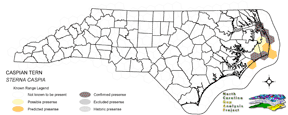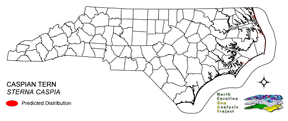
| Taxa: |
| Order: |
| Family: |
| Aves |
| Charadriiformes |
| Laridae |
| NatureServe Global Rank: |
| NatureServe State (NC) Rank: |
| G5 |
| S1B,S2N |
| Federal Status: |
| NC State Status: |
| --- |
| SR |


| Land Unit |
| US Fish & Wildlife Service |
| US Forest Service |
| US National Park Service |
| US Department of Defense |
| NC State Parks |
| NC University System |
| NC Wildlife Res. Com. |
| NC Forest Service |
| NC Div. of Coastal Mgmt. |
| Local Governments |
| Non-Governmental Org. |
| Other Public Lands |
| Private Lands |
| GAP Status 1-2 |
| All Protected Lands |
| Statewide |
| Hectares |
| 701.28 |
| 0.00 |
| 0.18 |
| 3,597.39 |
| 108.63 |
| 0.00 |
| 19.80 |
| 0.00 |
| 34.29 |
| 0.00 |
| 46.53 |
| 0.90 |
| 4,103.10 |
| 1,673.28 |
| 4,509.00 |
| 8,612.10 |
| Acres |
| 1,732.90 |
| 0.00 |
| 0.44 |
| 8,889.34 |
| 268.43 |
| 0.00 |
| 48.93 |
| 0.00 |
| 84.73 |
| 0.00 |
| 114.98 |
| 2.22 |
| 10,138.98 |
| 4,134.76 |
| 11,141.98 |
| 21,280.96 |
| % of Dist. on |
| Prot. Lands |
| 15.6 % |
| 0.0 % |
| < 0.1 % |
| 79.8 % |
| 2.4 % |
| 0.0 % |
| 0.4 % |
| 0.0 % |
| 0.8 % |
| 1.0 % |
| 1.0 % |
| < 0.1 % |
| 0.0 % |
| 37.1 % |
| ----- |
| ----- |
| % of Dist. on |
| All Lands |
| 8.1 % |
| 0.0 % |
| < 0.1 % |
| 41.8 % |
| 1.3 % |
| 0.0 % |
| 0.2 % |
| 0.0 % |
| 0.4 % |
| 0.0 % |
| 0.5 % |
| < 0.1 % |
| 47.6 % |
| 19.4 % |
| ----- |
| ----- |
|
Nests only in a few sites on the Outer Banks (Fussell 1994). Locally, nests in small colonies on ocean beaches on the Outer Banks (Fussell 1994, Portnoy et al. 1981). Forages primarily in tidal creeks and other sheltered sites (Fussell 1994) by diving and occasionally pirating food from other birds (Ehrlich et al. 1988). Prefers to forage in the sound rather than over the open ocean. In other parts of the species' range, also found along large fresh or salt water lakes and bays (Kaufman 1996). Nest is placed on the bare sand, and can be concealed in detritis, among shells or pieces of driftwood (Ehrlich et al. 1988), or occasionally on top of floating islands of debris (Kaufman 1996). NATURE SERVE GLOBAL HABITAT COMMENTS: Seacoasts, bays, estuaries, lakes, marshes, and rivers. Nests on sandy or gravelly beaches and shell banks along coasts or large inland lakes; sometimes with other water birds. Pacific coast populations formerly nested mainly in inland marshes, now mainly on human-created habitats (e.g., salt pond dikes and levees) along coast; nests on dredge-spoil islands in North Carolina and Florida. See Spendelow and Patton (1988) for further details. In northeastern Lake Michigan, tended to use same colony site in successive years unless previous reproductive effort was unsuccessful (Cuthbert 1988). |
| Code | Name | Description | NC Natural Heritage Program Equivalent |
| 378 | Ocean Beaches | Open beach sand. | Upper Beach |
| 375 | Hypersaline coastal salt flats | Tidal flats within salt marshes, including saltmeadow cordgrass or sea-purslane dominated alliances. | Salt Marsh |
| 371 | Maritime Grasslands | Dune grass community consisting of sea oats and beach grasses. | Dune grass, Maritime dry grassland |
| 380 | Coastal Plain Fresh Water Emergent | Emergent vegetation in fresh water seepage bogs, ponds and riverbeds of the coastal plain. Includes alliances dominated by sedges, eelgrass, as well as cane found in unforested cane-brakes. | Small Depression Pond, Sandhill Seep, Floodplain Pool, Unforested Floodplain Canebrake, Riverscour Prairies, Vernal Pools |
| 8 | Open water | Open water without aquatic vegetation. | No equivalent |
|
Shugart, G. W., M. A. Fitch, and V. M. Shugart. 1981. Minimizing investigator disturbance in observational studiesof colonial birds:access to blind through tunnels. WilsonBull. 93:565-569.
Bent, A.C. 1921. Life histories of North American gulls and terns. U.S. Natl. Mux. Bull. 113. Washington, D.C. Evers, D. C. 1992. A guide to Michigan's endangered wildlife. Univ. Michigan Press, Ann Arbor. viii + 103 pp. Hyslop, C., and J. Kennedy, editors. 1992. Bird trends:a report on results of national ornithological surveys in Canada. Number 2, Autumn 1992. Migratory Birds Conservation Division, Canadian Wildlife Service, Ottawa, Ontario. 20 pp. Fussell, J.O. III. 1994. A birderís guide to coastal North Carolina. Chapel Hill and London: The University of North Carolina Press. Kaufman K. 1996. Lives of North American Birds. Boston, New York: Houghton Mifflin Company. Gill, R. E., Jr., and L. R. Mewaldt. 1983. Pacific coast Caspian terns:dynamics of an expanding population. Auk 100:369-381. Kress, S. W., E. H. Weinstein, and I. C. T. Nisbet. 1983. The status of tern populations in the northeastern United States and adjacent Canada. Colonial Waterbirds 6:84-106. Buckley, P. A., and F. G. Buckley. 1984. Seabirds of the north and middle Atlantic coast of the United States:their status and conservation. Pages 101-133 in Croxall et al., eds. Status and conservation of the world's seabirds. ICBP Tech. Pub. No. 2. Cooper, J., A. J. Williams, and P. L. Britton. 1984. Distribution, population sizes and conservation of breeding seabirds in the Afrotropical region. Pages 403-419 in Croxall et al., eds. Status and conservation of the world's seabirds. ICBP Tech. Pub. No Evans, P. G. H. 1984. Status and conservation of seabirds in northwest Europe (excluding Norways and the USSR). Pages 293-321 in Croxall et al., eds. Status and conservation of the world's seabirds. ICBP Tech. Pub. No. 2. Feare, C. J. 1984. Seabird status and conservation in the tropical Indian Ocean. Pages 457-471 in Croxall et al., eds. Status and conservation of the world's seabirds. ICBP Tech. Pub. No. 2. Gallagher, M. D., et al. 1984. The distribution and conservation of seabirds breeding on the coasts and islands of Iran and Arabia. Pages 421-456 in Croxall et al., eds. Status and conservation of the world's seabirds. ICBP Tech. Pub. No. 2. Melville, D. S. 1984. Seabirds of China and the surrounding seas. Pages 501-511 in Croxall et al., eds. Status and conservation of the world's seabirds. ICBP Tech. Pub. No. 2. Quinn, J. S. 1984. Egg predation reduced by nest covers during research activities in a Caspian tern colony. Colonial Waterbirds 7:149-151. Robertson, C. J. R., and B. D. Bell. 1984. Seabird status and conservation in the New Zealand region. Pages 573-586 in Croxall et al., eds. Status and conservation of the world's seabirds. ICBP Tech. Pub. No. 2. Harrison, C. 1978. A field guide to the nests, eggs and nestlings of North American birds. Collins, Cleveland, Ohio. van Tets, G. F., and P. J. Fullagar. 1984. Status of seabirds breeding in Australia. Pages 559-571 in Croxall et al., eds. Status and conservation of the world's seabirds. ICBP Tech. Pub. No. 2. Cuthbert, F. J. 1985. Mate retention in Caspian terns. Condor 87:74-78. Terres, J.K. 1980. The Audubon Society encyclopedia of North American birds. Alfred A. Knopf, New York. American Ornithologists' Union (AOU), Committee on Classification and Nomenclature. 1983. Check-list of North American Birds. Sixth Edition. American Ornithologists' Union, Allen Press, Inc., Lawrence, Kansas. National Geographic Society (NGS). 1983. Field guide to the birds of North America. National Geographic Society, Washington, D.C. Smith, G. A. 1987. A selected and annotated bibliography for use in management of the Caspian tern (STERNA CASPIA). New York Dept. Environ. Conserv., Delmar, New York. 29 pp. Ehrlich, P.R., D.S. Dobkin, and D. Wheye. 1988. The birder's handbook:a field guide to the natural history of North American birds. Simon and Shuster, Inc., New York. xxx + 785 pp. Spendelow, J.A., and S.R. Patton. 1988. National atlas of coastal waterbird colonies in the contiguous United States:1976-1982. U.S. Fish and Wildlife Service, Biological Report 88(5). x + 326 pp. Byrd, M.A., and D.W. Johnston. 1991. Birds. Pages 477-537 in K. Terwilliger, coordinator. Virginia's endangered species:proceedings of a symposium. McDonald and Woodward Publ. Co., Blacksburg, Virginia. Cuthbert, F. J. 1988. Reproductive success and colony-site tenacity in Caspian terns. Auk 105:339-344. |
For more information please contact them at:
NC-GAP Analysis Project
Dept. of Zoology, NCSU
Campus Box 7617
Raleigh, NC 27695-7617
(919) 513-2853
a target="_blank">www.basic.ncsu.edu/ncgap